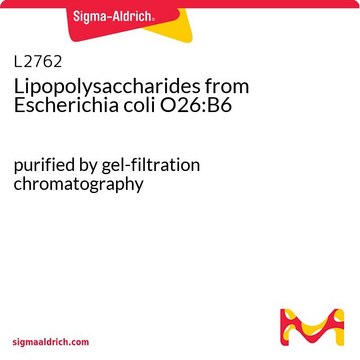L2143
Lipopolysaccharide aus Escherichia coli K-235
purified by phenol extraction
Synonym(e):
LPS
About This Item
Empfohlene Produkte
Biologische Quelle
Escherichia coli (K-235)
Qualitätsniveau
Form
lyophilized powder
Aufgereinigt durch
phenol extraction
Verunreinigungen
<3% Protein (Lowry)
Farbe
white to faint yellow
Löslichkeit
water: soluble
Versandbedingung
ambient
Lagertemp.
2-8°C
Suchen Sie nach ähnlichen Produkten? Aufrufen Leitfaden zum Produktvergleich
Allgemeine Beschreibung
Anwendung
- Establishment of disseminated intravascular coagulation (DIC) model by a single iv administration of Escherichia coli-derived lipopolysaccharide (LPS) to cynomolgus monkeys and evaluation of its pathophysiological status.: This study established a DIC model in cynomolgus monkeys using E. coli-derived LPS, providing insights into the pathophysiological status and potential therapeutic interventions for DIC (Minomo et al., 2017).
- Different bacterial lipopolysaccharides as toxicants and stressors in the shrimp Palaemon elegans.: This research explored the toxic effects of various bacterial LPS, including E. coli K-235, on the shrimp Palaemon elegans, advancing the understanding of LPS-induced stress responses in marine organisms (Lorenzon et al., 2002).
Biochem./physiol. Wirkung
Angaben zur Herstellung
Sonstige Hinweise
Ähnliches Produkt
Signalwort
Danger
H-Sätze
Gefahreneinstufungen
Acute Tox. 2 Oral
Lagerklassenschlüssel
6.1A - Combustible acute toxic Cat. 1 and 2 / very toxic hazardous materials
WGK
WGK 3
Flammpunkt (°F)
Not applicable
Flammpunkt (°C)
Not applicable
Persönliche Schutzausrüstung
Eyeshields, Gloves, type N95 (US)
Analysenzertifikate (COA)
Suchen Sie nach Analysenzertifikate (COA), indem Sie die Lot-/Chargennummer des Produkts eingeben. Lot- und Chargennummern sind auf dem Produktetikett hinter den Wörtern ‘Lot’ oder ‘Batch’ (Lot oder Charge) zu finden.
Besitzen Sie dieses Produkt bereits?
In der Dokumentenbibliothek finden Sie die Dokumentation zu den Produkten, die Sie kürzlich erworben haben.
Kunden haben sich ebenfalls angesehen
Unser Team von Wissenschaftlern verfügt über Erfahrung in allen Forschungsbereichen einschließlich Life Science, Materialwissenschaften, chemischer Synthese, Chromatographie, Analytik und vielen mehr..
Setzen Sie sich mit dem technischen Dienst in Verbindung.

